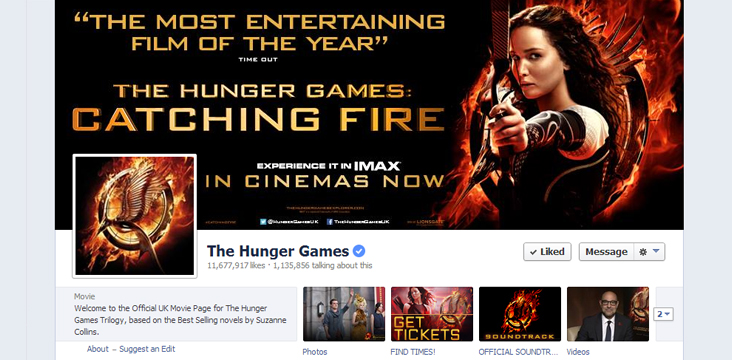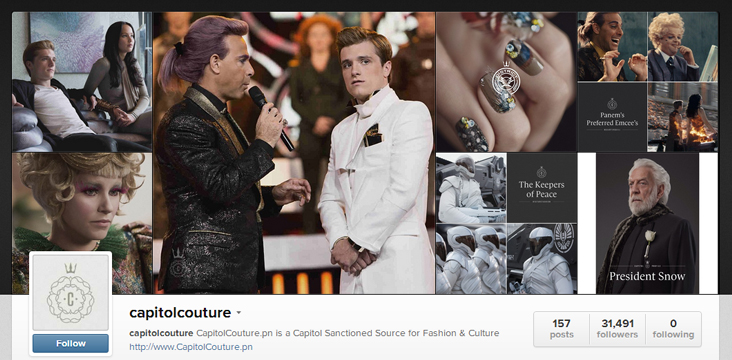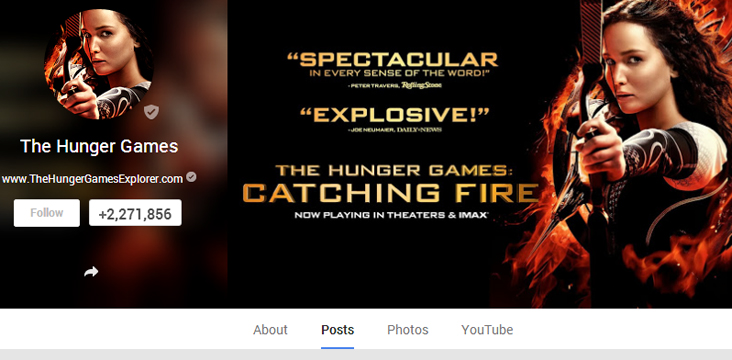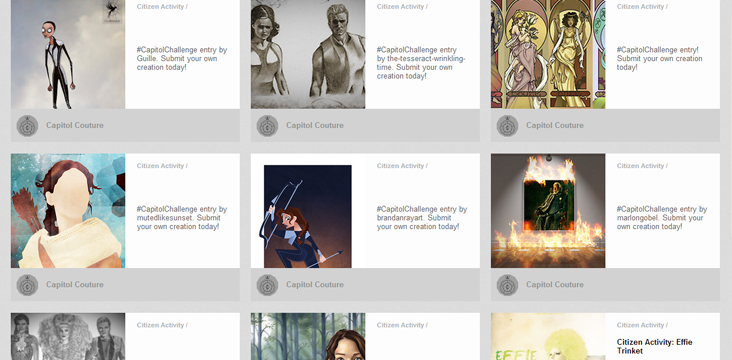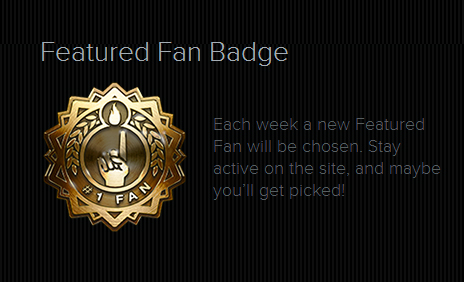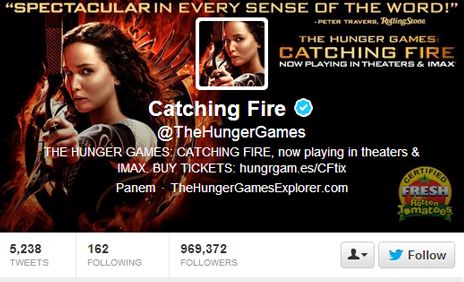News and Insights
Catching Fire: A Hunger Games Digital Marketing Case Study
November 22, 2013
Welcome, welcome to our 2nd Hunger Games case study blog. Last year I had the honour of looking at the social media marketing campaign for the first Hunger Games movie. I’m a massive Hunger Games fan and would devour Katniss’ tale late into the night when I really ought to be sleeping.
Catching Fire, the second movie based on the second book in the series has just been released internationally and is expected to break box office records. As with the marketing of the first movie, Lionsgate have really understood their target audience and set a precedent in using digital and social media marketing.
So grab your bow (or scary camouflage makeup skills) and join us as we take a dive into the digital marketing campaign of The Hunger Games: Catching Fire!
Catching Fire’s Target Channels
The Hunger Games invests a significant amount of time into their Facebook page, and boasting nearly 12 million likes shows it’s clearly working.
The Hunger Games Facebook page boasts nearly 12 million likes.
However, unlike when I originally looked at the Hunger Games’ social media marketing, they have reduced the focus on user generated content. As we’ll see later in this case study, they still place a huge focus on quality user generated content, but they currently centre their Facebook effort on promoting the upcoming movie.
One thing that they excel at is focusing on the visual. Each post is accompanied by picture ensuring a significant amount of likes, comments and shares.
A new weapon in the Hunger Games marketing artillery is the Capitol Couture Instagram profile. With so much visual content, you’d think it would be easy for Lionsgate to set up an official Instagram account but I think their focus on it being under their Capitol Couture brand (a sub-marketing brand focused on the fashion and design of the Hunger Games world), is a really smart move.
There are only so many photos of Katniss you can post on Instagram without being too repetitive. By focusing on their fashion and design, they can engage with a niche part of their audience. One of Instagram’s largest audiences is the fashion savvy hipsters that would never miss an #ootd.
Lionsgate have tailored their marketing approach on Instagram to the audience that they know is already there – putting the audience first and not their content.
Google+
Another new element of their marketing strategy is their Google+ account. I’m glad that more brands are using Google+; I personally like it and find that the engagement levels are more genuine and it is easier to communicate and create conversation.
Currently they are only using Google+ as an extension of their Facebook or Twitter accounts – pushing out movie related content. But with over 2 million encirclers, it’s certainly working and they often receive significant amounts of engagement.
In the future, I would like to see them push their Google+ community and be far more engaged with it. Google+ has a lot of interesting features – apps that can make use of Google Hangouts and YouTube to create an interactive, video-focused user experience.
Catching Fire’s User Generated Content
Tumblr
Capitol Couture is one of my favourite marketing channels Lionsgate have launched. One of the defining elements of the Hunger Games universe is the Capitol – a utopian, hyper-commercialised vision of the future where the visual is everything.
Tumblr’s focus on images, gifs and videos means any visual content gets devoured.
Capitol Couture focuses on the fashion and design of the Hunger Games world and highlights the unique, inspirational style of the world. Not only do they encourage audience participation but they also highlight the work and pieces of the designers that worked on the film.
But perhaps one of the smartest moves was to host this on Tumblr. Tumblr’s focus on images, animated gifs (you can now create a gif through Tumblr and your webcam) and videos means any visual content gets devoured.
But, more importantly they place a significant emphasis on user generated content – reinforcing their brand ambassadors and exponentially increasing their reach. They even have a whole tag dedicated to ‘Citizen Activity’.
Ultimate Fan Challenge
Consistently I am amazed at just how much focus Lionsgate have placed on the fans and the Hunger Games community – a lot of their marketing activity isn’t even necessarily directed at potential movie goers but how to engage the fans that no doubt will see the movie anyway.
For example, they have launched a whole gamification competition called the ‘Ultimate Fan Challenge’. People can register, use specific hashtags, earn points and enter competitions. They can also unlock badges for ultimate bragging rights which when shared by participants increases their social shares and reach.
But why would a film company spend so much time, effort and money on a marketing campaign that is preaching to the converted?
Importantly, they are encouraging the creation, and then utilising, an almost infinite amount of content. Companies would kill to have as much high quality, unique and truly engaging content as created by the Hunger Games fans.
By embracing this content, it only fuels the fire and encourages more fans to participate and get involved.
Embracing user generated content only fuels the fire and encourages more fans to participate
It also creates brand ambassadors overnight. If each one of their fans on Facebook shared one update from them and had on average 200 friends, they could have a potential reach of billions – can you imagine the cost for a traditional print or television campaign aimed at securing the same amount of viewership?
The Hunger Games’ social growth
When we originally wrote about the Hunger Games’ social media marketing, they had 6,308,164 Facebook likes and more than 550,000 Twitter followers.
Now, approximately 18 months later they have 11,647,406 Facebook likes – approximately 85% growth. This has bolstered by the smart move to consolidate their local Facebook pages into one (thanks for the heads up, Katie!). The Twitter account has grown to 969,372 followers – a 75% growth over the same period. They’ve also added to their social presence with a Google+ page with 2,271,856 encirclers and an Instagram profile with 31,464 followers.
That’s also not mentioning the hundreds of thousands of fans on their other profiles (for example the official Facebook and Twitter accounts of the Capitol), or the individual District Facebook pages.
Top digital marketing takeaway
For me, the number one takeaway that we can learn from the Hunger Gamers digital marketing campaign is to place the customer (or audience) at the heart of the campaign.
Start with understanding who your audience is.
- What are they interested in?
- Where do they congregate online?
- What kind of content resonates best with them?
Once you have identified this information – place it at the heart of your activity and never lose sight of it. Frequently I am asked as a digital marketer ‘but how do you know it will work?’ and of course I can’t always answer this question.
Good content should always engage with your target audience regardless of its purpose
But if you consider your target audience first and structure your digital marketing around them you have the best chance at resonating with them and ensuring you do not waste your time trying to push your marketing message on them.
Good content should always engage with your target audience regardless of its purpose. If you find that you are simply not getting any traction with your audience, consider going back to the planning phase and look at where and how you are considering your customers.
If you have any questions on digital marketing, social media marketing or content marketing then why not get in touch! Our digital marketing consultants would love to speak with you about your project.
-
TAGS:
- Technology
